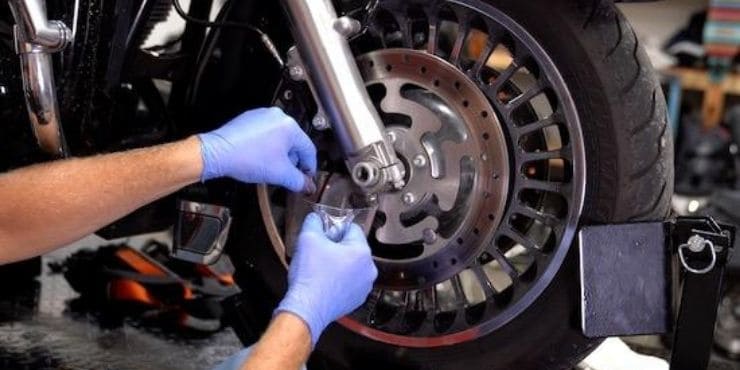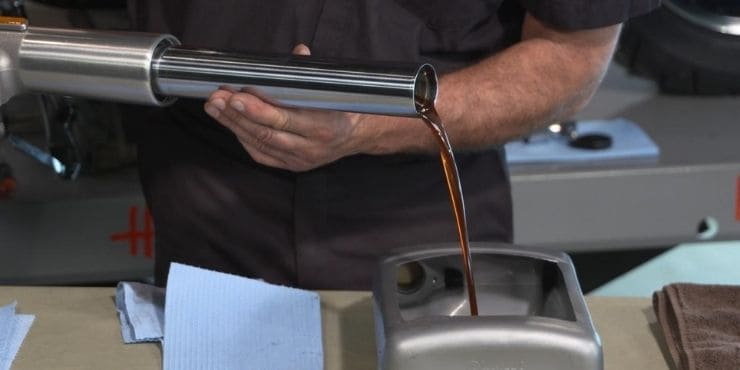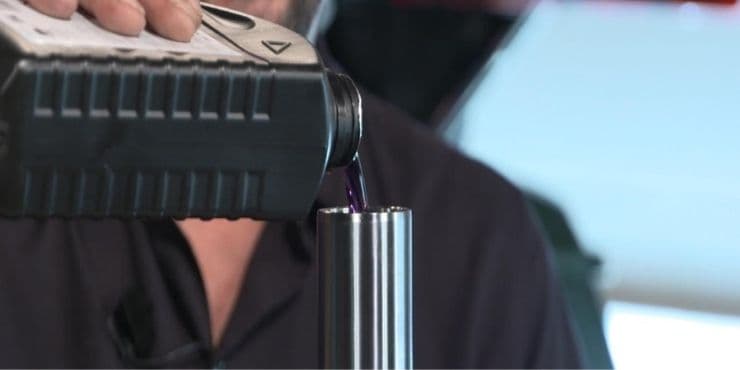Getting your Harley-Davidson bike services and looking to know how much fork oil will you need? If so, then you’re in the right place
The amount of fork oil required for a Harley-Davidson varies by model, but most take between 10 to 12 ounces per fork. Always check your service manual for the exact specification.
In this article, you’ll get to know all about fork oil, why you should replace it with time, how much oil do I need, and more. Continue reading to know more.
How much fork oil do I need for my Harley-Davidson?
Fork oil in a Harley-Davidson motorcycle acts as the dampener for the vibrations coming from the front wheel. The smooth riding experience that you enjoy on your Harley-Davidson bike is partly due to the fork oil. For keeping the front suspension in great working condition, you must change the fork oil from time to time.
The front for oil capacity will vary across the motorcycles depending upon the model and the bike. Typically, you will need to add around 11.2 oz. or 300ml of fork oil to your Harley-Davidson bike. A simple way of adding fork oil to your bike would be by adding the right amount of oil. Then, using a suction pump, take out a little bit.
The primary function of fork oil is dampening the vibrations that come to the main frame from the front wheel. Over time, the dampening properties of the oil will decrease, and you’ll have to replace the old oil with new fork oil. The exact time to change the fork oil can vary from model to model, and it can be found in the owner’s manual. Usually, the time will range between 10,000 and 20,000 depending upon the model of the bike. As a general rule of thumb, the fork oil must be changed every 10,000 miles or 16,000 kilometers.
Further, it is recommended for Harley-Davidson riders that the fork oil must be drained and refilled either every 10,000 miles traveled or once per year. For some models, there could be different rules depending upon various factors. However, the range is still between 10,000 and 20,000 miles. It’s safe to say it would be better to change the oil early than to change the oil too late. Not changing the fork oil on time might end up being harmful to your bike. Meanwhile, changing the fork oil on time would keep the front suspension and forks in great working condition.
Bad fork oil could end up ruining your driving experience
Forks will connect the bike’s frame to the front wheel. The vibrations coming from the front wheel because of traction on the road need to be dampened. This is normally done by the front forks. This is why having a great suspension is important. The forks will absorb the vibrations from the front wheel and not let them pass to the rider. A good fork oil will offer a smooth riding experience and premium comfort to the Harley-Davidson rider.

In case the fork oil is old, unchanged, and isn’t in working condition, the ride will be far from smooth. You will be able to notice the difference, while the handlebar will also not function as expected. Bad fork oil will result in increased vibration and a terrible riding experience. If you’re noticing these symptoms, it’s likely that you should change the fork oil or get the front forks inspected.
Maintain fork oil for a better riding experience
Fork oils are often the unsung heroes of Harley-Davidson bikes. It silently goes about its job without even getting noticed or taking any credit. The next time you’re going through uneven terrain and you don’t feel a thing on your handlebars, you should know who made it possible. When it comes to maintaining fork oil, it is very simple. The fork oil is kept in closed chambers located at the front of the Harley-Davidson motorcycles. It’s because of that reason that it doesn’t come in contact with any external factors until engine oils. Moreover, fork oil will also retain its viscosity and quality for a long time.
When you’re getting your Harley-Davidson bike serviced, just get the front shock absorber and forks checked. If you feel that it’s getting rough, or making squeaking noises, it’ll be time to get a fork oil change. If you’re someone who doesn’t ride their bike regularly, it’s recommended that you should still get the oil changed yearly. Ensure that you’re using the right grade specified in the owner’s manual. The grade will be decided depending on the load, the road conditions, and other factors. You should never try to experiment with fork oils of different grades.
Using the right fork oil grades is necessary
Fork oils will be graded depending on the load-carrying capacity, the viscosity, and a few other factors. Different manufacturers and different models will use different oil grades as the load will vary. For instance, a Harley-Davidson touring bike will need a highly viscous oil for balancing the heavy load, while a sports bike will likely need a less viscous option. The fork oil will come with its own SAE grading system. This ranges in the multiples of 5 (i.e. 5WT, 10WT, 15WT, and so on). The higher the number, the better will be the load-carrying capacity of the oil. You should make sure that you’re checking the owner’s manual to know the exact fork oil grading.
It’s recommended that you should stick to the fork oil brand that is used by your motorcycle manufacturer. If you’re going for an alternative, there are a few things to be varied about. Although the oil of a different brand might have the same SAE grading system, its viscosity could be different. It would be a smart move to get the oil checked by an expert before you use it. Otherwise, the wrong oil could affect the bike’s performance and leave you with unnecessary issues.

Ultimately, you must ensure that the fork oil you’re using is proper. You should replace it after a year or so, depending upon how frequently you use your bike. A little care and maintenance will go a long way in improving your bike’s performance. Improper fork performance can easily lead to damage to your bike, the assembly, and more. Meanwhile, heavy jerks on an uneven surface could lead to accidents or even cracks in your bike.
Important tips to remember when changing the fork oil
Changing the fork oil is something that should be left to the experts. As the entire fork assembly is a complicated unit, it should be left for folks at the service center to handle. However, if you love the DIY way, you could have a go as long as you know what you’re doing. Here are a few important tips that you must keep in mind when changing the fork oil.
- You should ensure that you change the fork oil one fork at a time. If possible, you shouldn’t get the piston of the forks out.
- Make sure that you check if the fork features an oil-draining outlet. If it is present, you’re very lucky. If it isn’t, then you must go through the trouble of opening the piston and the spring setup. Then, you’ll have to get the oil out and refill it.
- Ensure that you’re putting in the exact amount of fork oil that is mentioned in the manual. If it isn’t mentioned, then Harley-Davidson motorcycles usually require 300ml of fork oil. Another alternate option is to drain out the oil, measure the amount, and fill the exact amount as you drained out. If you don’t have anything to measure, you can simply use a thin strip or a metal rod. It’ll allow you to measure the amount of oil that was present using the length. Then, fill in the exact amount with the new oil as it was inside previously.
- Once you’ve changed the oil, pump up the forks a few times until the air bubbles inside have completely escaped. Then, you will be able to notice the difference in the shock-absorbing capacity of the front forks.
- Never do this without a safe, secure way of holding the bike as you’re removing and re-installing the fork legs.
- Most modern forks don’t come with drain screws at the bottom of the fork. Without them, you will need to suck the oil out using a syringe. Alternatively, you can also remove the fork legs and then drain them using gravity by holding them upside down.
- Fork oil is a specific type of oil product. It isn’t like motor oil. This type of oil is designed for performing one task. This is why you must go for the right fork oil as there aren’t any alternatives. Fork oil will come in a variety of viscosity grades and weights. Fork oils can be easily purchased on the internet while they’re also sold in motorcycle shops.
- Start off by loosening the bolts while keeping some weight on the front end. Lift the Harley-Davidson motorcycle’s front end before removing the front wheel. Once you have the front wheel removed, it would be a great time to look at the brake pads.
- The fork tube caps will be under pressure, and you should look out for the cap flying off.
- Remember to take note of the different parts that are coming out of each leg. Moreover, also remember the order they’re coming out in. You will need to ensure that you’re putting them back in the same order they came out.
- The amount of oil to be added must be measured precisely. You will need to do one site at a time so that you aren’t missing anything.
- Most forks will come with 1-2 thin washers on top of the spring. They’ll be very easy to miss and lose. You need to watch out for them.
- The last bolts that should be tightened are the 1-2 bolts at the bottom of the fork leg on each side. Leave it until you’re done with everything else. Bounce the front end up and down before you finally tighten the bolts to factory settings.
Conclusion
Thank you for reading. Hopefully, now you will allot more about fork oil, why it must be changed, and how much fork oil do I need. Generally, Harley-Davidson motorcycles require around 11.2 oz. or 300ml of fork oil. You must change the fork oil every 10,000 miles or every year, whichever comes first. The fork oil will act as the dampener for the vibrations coming from the front wheel to the bike’s frame. By keeping the fork oil in check, you would have taken the first step to guarantee a smooth riding experience.

